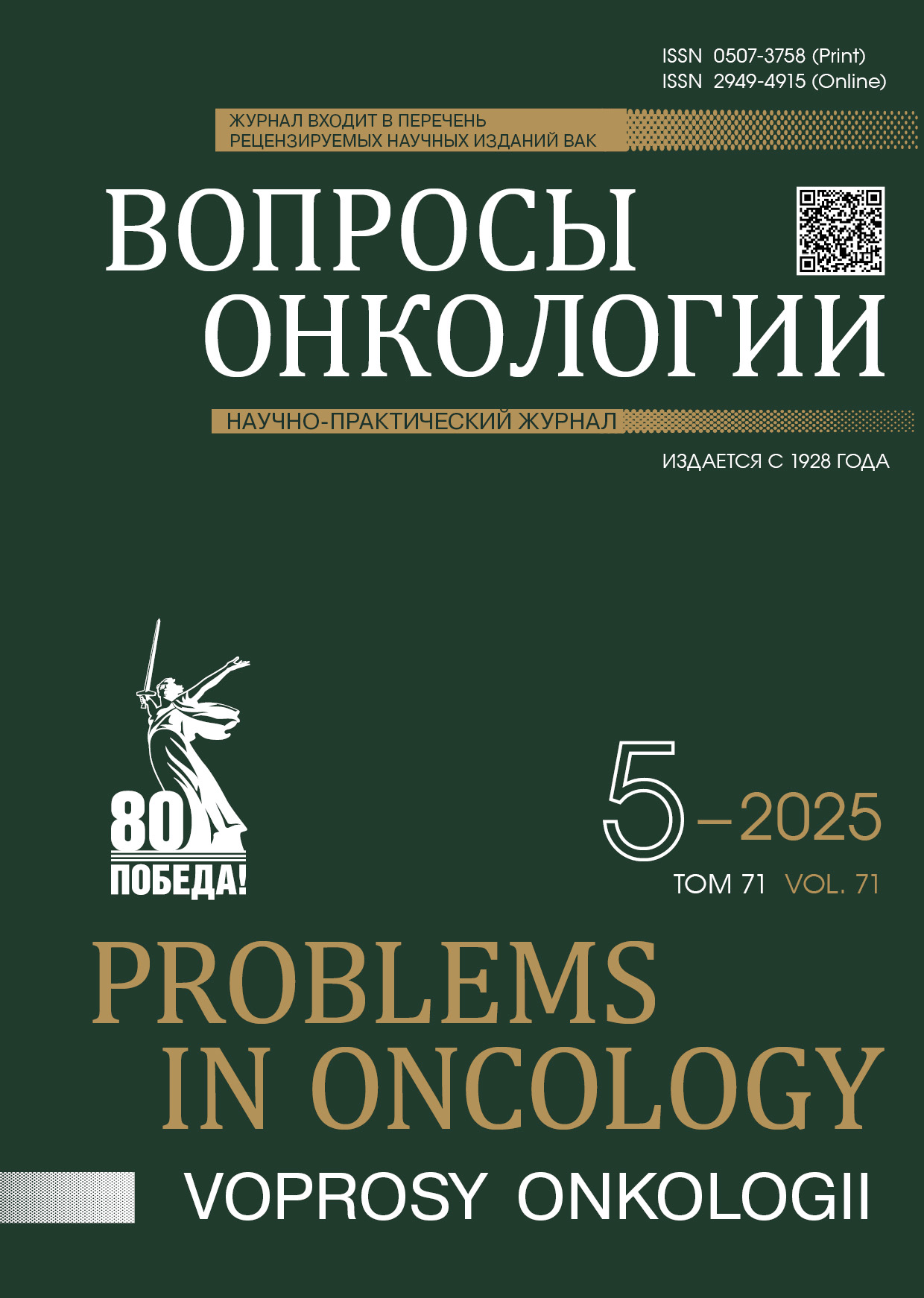摘要
Введение. Хордомы и хондросаркомы основания черепа — редкие радиорезистентные опухоли с высокой склонностью к локальным рецидивам, требующие комплексного подхода в лечении. Наиболее оптимальным методом лечения данных новообразований исторически считается протонная терапия сканирующим пучком.
Цель. Оценить эффективность и безопасность протонной терапии с использованием сканирующего пучка при лечении хордом и хондросарком основания черепа.
Материалы и методы. В исследование были включены пациенты с хордомой и хондросаркомой основания черепа, которым была проведена протонная терапия на комплексе протонной терапии «Прометеус» (ЗАО «Протом») на базе МРНЦ им. А.Ф. Цыба. Планы лучевой терапии подготовлены с применением планирующей системы ProtomTherapyPlanner ver. 1.12-2.14 и алгоритма Монте-Карло. Были оценены показатели общей выживаемости, локального контроля и токсичности. Оценка ответа опухоли проводилась согласно критериям RECIST 1.1. Токсичность лечения определялась с использованием критериев классификации CTCAE v5.0.
Результаты. С 2016 по 2024 г. в исследовании приняли участие 62 пациента с хордомой (n = 46) и хондросаркомой (n = 16) основания черепа. Медиана наблюдения составила три года. Медиана объема GTV была равна 23 см3 (IQR = 12–39). Средняя СОД составила 70 изоГр (64-74 изоГр). Однолетняя и трехлетняя общая выживаемость — 98,4 и 94,1 % соответственно. Локальный контроль в течение первого года составил 100 %, а в течение третьего года — 77,9 %. Пациенты со статусом ECOG 0-1 имели статистически значимо лучшие показатели выживаемости и локального контроля (p < 0,05). У пациентов без хирургического лечения в анамнезе с опухолью, расположенной вблизи ствола головного мозга, наблюдались более низкие показатели локального контроля. Лучевые осложнения тяжелой степени тяжести отмечены у 1,6 % пациентов.
Выводы. Применение протонной терапии сканирующим пучком обеспечило высокие показатели общей выживаемости и локального контроля при низкой токсичности. Лучшие результаты лечения отмечались у пациентов с удовлетворительным соматическим статусом (ECOG 0-1), проходивших комбинированную терапию. Кроме того, локализация опухоли вблизи ствола головного мозга отрицательно влияла на показатели локального контроля.
参考
Mizerny B.R., Kost K.M. Chordoma of the cranial base: the McGill experience. J Otolaryngol. 1995; 24(1): 14-9.
Lee S.Y., Lim Y.C., Song M.H., et al. Chondrosarcoma of the head and neck. Yonsei Med J. 2005; 46(2): 228-32.-DOI: https://doi.org/10.3349/ymj.2005.46.2.228.
Biermann J.S., Hirbe A., Ahlawat Sh., et al. Bone cancer. NCCN Guidelines: NCCN. 2025; version 2.2025: 53-57.-URL: https://www.nccn.org/professionals/physician_gls/pdf/bone.pdf.
Casali P.G., Bielack S., Abecassis N., et al.; ESMO Guidelines Committee, PaedCan and ERN EURACAN. Bone sarcomas: ESMO-PaedCan-EURACAN Clinical Practice Guidelines for diagnosis, treatment and follow-up. Ann Oncol. 2018; 29(Suppl 4): 79-95.-DOI: https://doi.org/10.1093/annonc/mdy310.
Tzortzidis F., Elahi F., Wright D., et al. Patient outcome at long-term follow-up after aggressive microsurgical resection of cranial base chordomas. Neurosurgery. 2006; 59(2): 230-7.-DOI: https://doi.org/10.1227/01.neu.0000223441.51012.9d.
Samii A., Gerganov V., Herold C., et al. Surgical treatment of skull base chondrosarcomas. Neurosurg Rev. 2009; 32: 67-75.-DOI: https://doi.org/10.1007/s10143-008-0170-4.
Tzortzidis F., Elahi F., Wright D.C., et al. Patient outcome at long-term follow-up after aggressive microsurgical resection of cranial base chondrosarcomas. Neurosurgery. 2006; 58: 1090-8.-DOI: https://doi.org/10.1227/01.neu.0000215892.65663.54.
Sekhar L.N., Pranatartiharan R., Chanda A., et al. Chordomas and chondrosarcomas of the skull base: Results and complications of surgical management. Neurosurg Focus. 2001; 10: 1-4.-DOI: https://doi.org/10.3171/foc.2001.10.3.3.
Almefty K., Pravdenkova S., Colli B.O., et al. Chordoma and chondrosarcoma: similar, but quite different, skull base tumors. Cancer. 2007; 110(11): 2457-67.-DOI: https://doi.org/10.1002/cncr.23073.
Weber D.C., Rutz H.P., Pedroni E.S., et al. Results of spot-scanning proton radiation therapy for chordoma and chondrosarcoma of the skull base: The Paul Scherrer Institut experience. Int J Radiat Oncol Biol Phys. 2005; 63: 401-9.-DOI: https://doi.org/10.1016/j.ijrobp.2005.02.023.
Ares C., Hug E.B., Lomax A.J., et al. Effectiveness and safety of spot scanning proton radiation therapy for chordomas and chondrosarcomas of the skull base: first long-term report. Int J Radiat Oncol Biol Phys. 2009; 75(4): 1111-8.-DOI: https://doi.org/10.1016/j.ijrobp.2008.12.055.
Weber D.C., Malyapa R., Albertini F., et al. Long term outcomes of patients with skull-base low-grade chondrosarcoma and chordoma patients treated with pencil beam scanning proton therapy. Radiother Oncol. 2016; 120(1): 169-74.-DOI: https://doi.org/10.1016/j.radonc.2016.05.011.
Hug E.B., Loredo L.N., Slater J.D. Proton radiation therapy for chordomas and chondrosarcomas of the skull base. J Neurosurg. 1999; 91(3): 432-9.-DOI: https://doi.org/10.3171/jns.1999.91.3.0432.
Munzenrider J.E., Liebsch N.J. Proton therapy for tumors of the skull base. Strahlenther Onkol. 1999; 175(S2): 57-63.-DOI: https://doi.org/10.1007/bf03038890.
Stacchiotti S., Sommer J. Building a global consensus approach to chordoma: A position paper from the medical and patient community. Lancet Oncol. 2015; 16(2): 71-83.-DOI: https://doi.org/10.1016/S1470-2045(14)71190-8.
Palm R.F., Oliver D.E., Yang G.Q., et al. The role of dose escalation and proton therapy in perioperative or definitive treatment of chondrosarcoma and chordoma: an analysis of the National Cancer Data Base. Cancer. 2019; 125(4): 642-51.-DOI: https://doi.org/10.1002/cncr.31958.
Holtzman A.L., Bates J.E., Morris C.G., et al. Impact of type of treatment center and access to care on mortality and survival for skull base chordoma and chondrosarcoma. J Neurol Surg B Skull Base. 2021; 83(3): 328-38.-DOI: https://doi.org/10.1055/s-0040-1722228.
Liu H., Chang J.Y. Proton therapy in clinical practice. Chin J Cancer. 2011; 30(5): 315-26.-DOI: https://doi.org/10.5732/cjc.010.10529.
Stacchiotti S., Sommer J., et al. Building a global consensus approach to chordoma: a position paper from the medical and patient community. Lancet Oncol. 2015; 16(2): e71-83.-DOI: https://doi.org/10.1016/S1470-2045(14)71190-8.
Валиев А.К., Тепляков В.В., Мусаев Э.Р., et al. Практические рекомендации по лечению первичных злокачественных опухолей костей. Злокачественные опухоли. 2022; 12(3s2): 323-325.-DOI: https://doi.org/10.18027/2224-5057-2022-12-3s2-307-329.-URL: https://rosoncoweb.ru/standarts/RUSSCO/2022/2022-17.pdf. [Valiev A.K., Teplyakov V.V., Musaev E.R., et al. Practical recommendations for the treatment of primary malignant bone tumors. Malignant tumors. 2022; 12(3s2): 323-325.-DOI: https://doi.org/10.18027/2224-5057-2022-12-3s2-307-329.-URL: https://rosoncoweb.ru/standarts/RUSSCO/2022/2022-17.pdf (In Rus)].
Gordon K., Gulidov I., Koryakin S., et al. Proton therapy with a fixed beamline for skull-base chordomas and chondrosarcomas: outcomes and toxicity. Radiat Oncol. 2021; 16(1): 238.-DOI: https://doi.org/10.1186/s13014-021-01961-9.
Lemaeva A., Gulidov I., Smyk D., et al. A single-center experience of the upright proton therapy for skull-base chordomas and chondrosarcomas: Updated results. Clin Transl Radiat Oncol. 2024; 48: 100814.-DOI: https://doi.org/10.1016/j.ctro.2024.100814

This work is licensed under a Creative Commons Attribution-NonCommercial-NoDerivatives 4.0 International License.
© АННМО «Вопросы онкологии», Copyright (c) 2025

